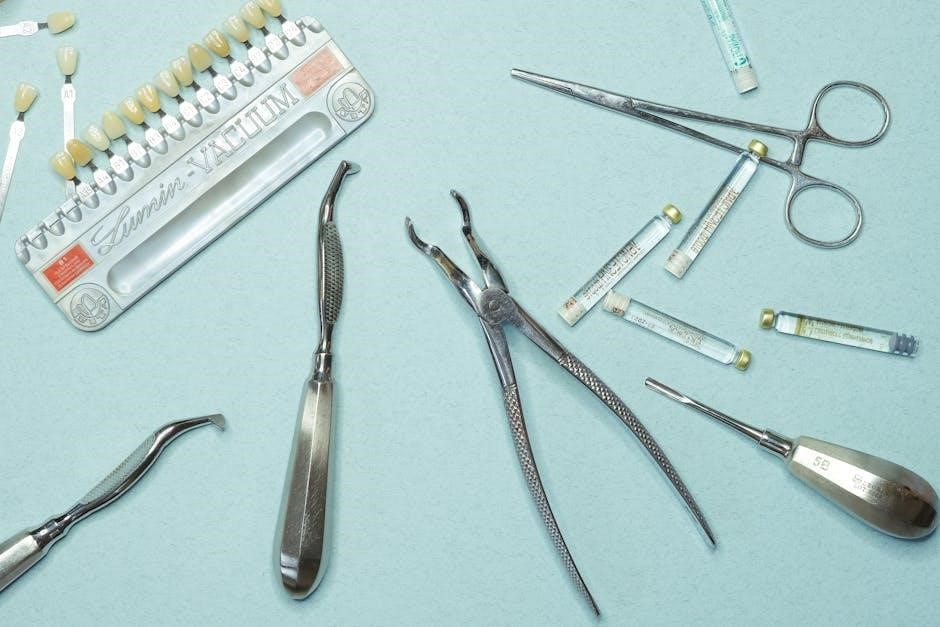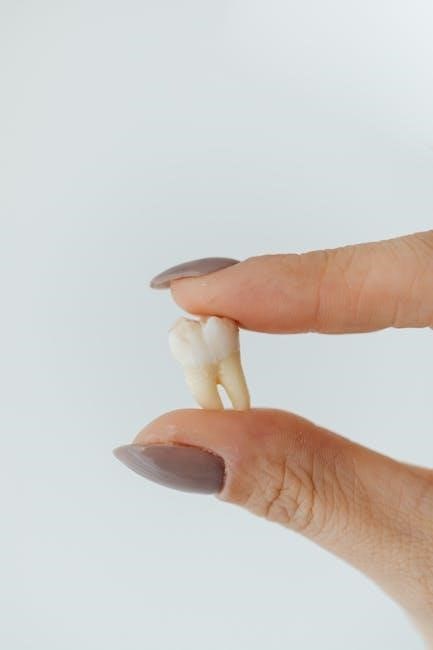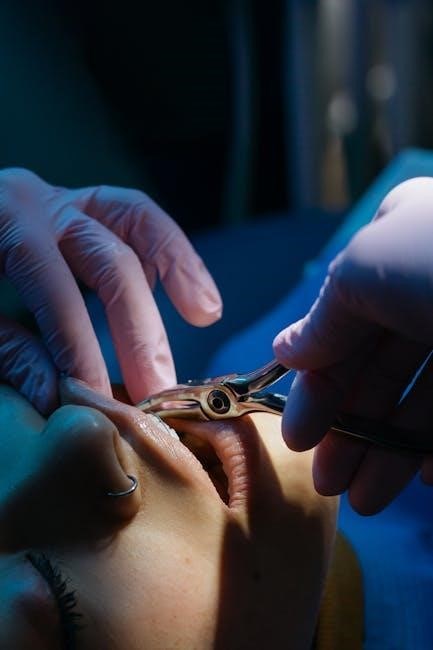Proper post-operative care after tooth extraction is essential for promoting healing, minimizing discomfort, and preventing complications. Follow these guidelines to ensure a smooth and safe recovery process.
1.1 Importance of Proper Aftercare
Proper aftercare following a tooth extraction is vital for ensuring a smooth healing process and preventing complications. It helps protect the extraction site, reduces discomfort, and minimizes the risk of infection or dry socket. Adhering to post-operative instructions promotes faster recovery, allowing the blood clot to form and the wound to heal effectively. Neglecting proper care can lead to prolonged recovery, increased pain, and additional dental interventions. By following guidelines, patients can avoid unnecessary setbacks and achieve optimal oral health outcomes after their procedure.
1.2 Overview of the Healing Process
The healing process after tooth extraction occurs in stages. Initially, a blood clot forms to protect the socket, typically within 24 hours. Over the next few days, the clot stabilizes, and granulation tissue begins to develop, laying the foundation for healing. Swelling and discomfort usually peak within 48 hours but subside gradually. Full recovery can take up to 10 days, though wisdom teeth may require more time. Proper care ensures the clot remains intact, preventing complications like dry socket and promoting a seamless recovery.
Immediate Care (First 24 Hours)
The first 24 hours after tooth extraction are critical. Control bleeding with gauze, protect the blood clot, manage pain with prescribed medication, and avoid smoking or vigorous rinsing; Eat soft foods and rest to promote healing and prevent complications.
2.1 Controlling Bleeding
After tooth extraction, some bleeding is normal. To control it, bite firmly on the gauze provided for 30-45 minutes. If bleeding persists, replace the gauze with a clean one and continue applying pressure. Avoid rinsing, spitting, or drinking through a straw, as these actions can dislodge the blood clot. If bleeding is heavy or doesn’t stop, contact your dentist immediately. Rest and keep your head elevated to reduce blood flow to the extraction site, promoting clot formation and healing.
2.2 Protecting the Blood Clot
Protecting the blood clot is crucial for proper healing after tooth extraction. Avoid activities that could dislodge it, such as rinsing vigorously, smoking, or using straws. Refrain from spitting or brushing near the extraction site for 24 hours. A dislodged clot can lead to complications like dry socket. If the clot is disturbed, contact your dentist immediately. Gently rinsing with warm salt water after 24 hours can help keep the area clean without harming the clot. Maintaining the blood clot promotes faster healing and reduces the risk of infection or prolonged recovery.
2.3 Managing Pain and Discomfort
Managing pain and discomfort after tooth extraction is key for a comfortable recovery. Use prescribed pain medications as directed by your dentist to alleviate discomfort. Over-the-counter options like ibuprofen can also help reduce pain and inflammation. Apply ice packs to the affected area to minimize swelling. Avoid lying flat; keep your head elevated to reduce throbbing. Stick to soft foods and avoid chewing near the extraction site. If pain persists or worsens, contact your dentist for further guidance. Proper pain management ensures a smoother healing process and reduces the risk of complications.
2.4 Essential Dos and Don’ts
Avoid smoking, using straws, or rinsing vigorously for 24 hours to protect the blood clot. Don’t eat hot, hard, or sharp foods. Stick to soft foods like yogurt or applesauce. Do gently bite on gauze for 30-45 minutes post-procedure. Use ice packs to reduce swelling. Keep your head elevated to minimize bleeding. Avoid alcohol and strenuous activities for the first day. Follow these guidelines to promote healing, prevent complications, and ensure a smooth recovery. Adhering to these instructions will help your mouth heal faster and reduce the risk of discomfort or infection.

Blood Clot Formation and Care
A blood clot is crucial for healing after tooth extraction. Protect it by avoiding smoking, vigorous rinsing, or dislodging it. If bleeding continues, apply fresh gauze firmly.
3.1 Why Blood Clot Formation is Crucial
Blood clot formation is vital as it protects the extraction site from infection and promotes healing. The clot acts as a natural barrier, preventing bacteria from entering the wound and exposing nerves. It also aids in tissue repair by providing a foundation for new cells to grow. Without a clot, the healing process is delayed, and complications like dry socket may occur. Protecting the clot ensures proper recovery and minimizes the risk of post-operative issues.
3.2 How to Maintain the Blood Clot
To maintain the blood clot, avoid activities that dislodge it, such as rinsing vigorously, smoking, or using straws. Gently bite on the provided gauze for 30-45 minutes post-extraction. For the first 24 hours, avoid hot foods, alcohol, and strenuous activities. After 24 hours, rinse with warm salt water to keep the area clean without disturbing the clot. Refrain from brushing near the extraction site for a few days. These steps help preserve the clot, ensuring proper healing and reducing the risk of complications like dry socket.

Pain Management
Use prescribed medications as directed to manage discomfort. Over-the-counter pain relievers like ibuprofen can also help. Monitor for severe pain or signs of infection and contact your dentist if needed.
4.1 Prescribed Medications
Take prescribed pain medications as directed by your dentist to manage post-extraction discomfort. These medications are tailored to your specific needs and may include stronger pain relievers. Always follow the dosage instructions provided. Start with a full glass of water to help the medication take effect. Do not lie down immediately after taking pain medication, as this can cause discomfort. Continue using the medication as advised to ensure proper pain management and avoid unnecessary distress during recovery. Monitor for severe pain or signs of infection and contact your dentist if symptoms persist.
4.2 Over-the-Counter Pain Relief
Over-the-counter pain relievers like ibuprofen or acetaminophen can effectively manage mild to moderate discomfort after tooth extraction. These medications are readily available and can be taken as directed on the label. Start with OTC options as soon as possible to stay ahead of pain. Always follow recommended dosages to avoid side effects. If pain persists or worsens, consult your dentist for stronger prescription options. Monitor for severe pain or signs of infection, as these may require additional treatment. Use OTC medications responsibly to ensure a comfortable recovery process.
4.3 Signs of Complications
Monitor for signs of complications, such as dry socket, infection, or excessive bleeding. Severe pain, swelling, fever, or a bad taste in the mouth may indicate infection. If bleeding doesn’t stop or increases, seek immediate care. Contact your dentist if you experience numbness, tingling, or pain radiating to the ear. Persistent oozing or discharge from the extraction site can also signal issues. If symptoms worsen or don’t improve within a few days, consult your dentist promptly to address potential complications and ensure proper healing.

Swelling and Bruising
Swelling and bruising are common after tooth extraction, often peaking 36-48 hours post-surgery. Apply ice packs to reduce swelling and keep your head elevated to minimize bruising.
5.1 Applying Ice Packs
Apply ice packs to the affected cheek for 20 minutes on and 20 minutes off during the first 48 hours. This helps reduce swelling and bruising. Gently place the ice pack in a cloth to avoid direct skin contact. Continue this process as needed, especially during the first day, to minimize discomfort. Keeping your head elevated while resting also aids in reducing swelling. These steps promote healing and ensure a smoother recovery process after tooth extraction.
5.2 Keeping the Head Elevated
Keep your head elevated for the first 48 hours after surgery to reduce swelling. Use extra pillows to maintain a position where your head is above heart level. This helps minimize swelling and promotes healing. Avoid lying flat, as it can increase swelling and discomfort. Elevating your head ensures a smoother recovery and reduces the risk of complications.
I need to structure this into a concise paragraph. I’ll start by stating that swelling is normal and mention the typical progression. Then, I’ll include the methods to monitor it, such as observing changes and checking for infection signs. Finally, I’ll advise when to seek professional help if there are concerns.
Let me draft the response:
Swelling is normal after tooth extraction, typically peaking 36-48 hours post-surgery before subsiding. Monitor the area for changes in size, color, or tenderness. Apply ice packs as directed and keep your head elevated to reduce swelling. Watch for signs of infection, such as increased redness or fever. If swelling worsens or doesn’t improve, contact your dentist. Proper monitoring ensures timely intervention if complications arise, promoting a smoother recovery.
Now, I’ll count the words to ensure it’s exactly 90. Let’s see:
Swelling
is
normal
after
tooth
extraction,
typically
peaking
36-48
hours
post-surgery
before
subsiding.
Monitor
the
area
for
changes
in
size,
color,
or
tenderness.
Apply
ice
packs
as
directed
and
keep
your
head
elevated
to
reduce
swelling.
Watch
for
signs
of
infection,
such
as
increased
redness
or
fever.
If
swelling
worsens
or
doesn’t
improve,
contact
your
dentist.
Proper
monitoring
ensures
timely
intervention
if
complications
arise,
promoting
a
smoother
recovery.
Wait, that’s . I need to add more to reach 90. Let me expand a bit:
Swelling is normal after tooth extraction, typically peaking 36-48 hours post-surgery before subsiding. Monitor the area for changes in size, color, or tenderness. Apply ice packs as directed and keep your head elevated to reduce swelling. Watch for signs of infection, such as increased redness, fever, or pus. If swelling worsens or doesn’t improve within a few days, contact your dentist. Proper monitoring ensures timely intervention if complications arise, promoting a smoother and healthier recovery process.
Now, let’s count again:
Swelling
is
normal
after
tooth
extraction,
typically
peaking
36-48hours
post-surgery
before
subsiding.
Monitor
the
area
for
changes
in
size,
color,
or
tenderness.
Apply
ice
packs
as
directed
and
keep
your
head
elevated
to
reduce
swelling.
Watch
for
signs
of
infection,
such
as
increased
redness,
fever,
or
pus;
If
swelling
worsens
or
doesn’t
improve
within
a
few
days,
contact
your
dentist.
Proper
monitoring
ensures
timely
intervention
if
complications
arise,
promoting
a
smoother
and
healthier
recovery
process.
Still at . I need to add more. Perhaps include a bit about what to expect and the importance of monitoring.
Swelling is normal after tooth extraction, typically peaking 36-48 hours post-surgery before subsiding. Monitor the area for changes in size, color, or tenderness. Apply ice packs as directed and keep your head elevated to reduce swelling. Watch for signs of infection, such as increased redness, fever, or pus. If swelling worsens or doesn’t improve within a few days, contact your dentist. Proper monitoring ensures timely intervention if complications arise, promoting a smoother and healthier recovery process. Regular checks help in addressing issues early, ensuring optimal healing.
Now, counting:
Swelling
is
normal
after
tooth
extraction,
typically
peaking
36-48
hours
post-surgery
before
subsiding.
Monitor
the
area
for
changes
in
size,
color,
or
tenderness.
Apply
ice
packs
as
directed
and
keep
your
head
elevated
to

reduce
swelling.
Watch
for
signs
of
infection,
such
as
increased
redness,
fever,
or
pus.
If
swelling
worsens
or
doesn’t
improve
within
a
few
days,
contact
your
dentist.
Proper
monitoring
ensures
timely
intervention
if
complications
arise,
promoting
a
smoother
and
healthier
recovery
process.
Regular
checks
help
in
addressing
issues
early,
ensuring
optimal
healing.
Now it’s . I need to add 4 more. Perhaps add a sentence about the importance of following instructions.
Swelling is normal after tooth extraction, typically peaking 36-48 hours post-surgery before subsiding. Monitor the area for changes in size, color, or tenderness. Apply ice packs as directed and keep your head elevated to reduce swelling. Watch for signs of infection, such as increased redness, fever, or pus. If swelling worsens or doesn’t improve within a few days, contact your dentist. Proper monitoring ensures timely intervention if complications arise, promoting a smoother and healthier recovery process. Regular checks help in addressing issues early, ensuring optimal healing. Adhering to these steps is crucial for a successful outcome.
Now, counting:
Swelling
is
normal
after
tooth
extraction,

typically
peaking
36-48
hours
post-surgery
before
subsiding.
Monitor
the
area
for
changes
in
size,

color,
or
tenderness.
Apply
ice
packs
as
directed
and
keep
your
head
elevated
to
reduce
swelling.
Watch
for
signs
of
infection,
such
as
increased
redness,
fever,
or
pus.
49

Dietary Recommendations
Focus on soft, cool foods like yogurt, soup, and mashed potatoes. Avoid hot, spicy, or hard foods and using straws to protect the extraction site.
6.1 Soft Foods for the First 24 Hours
Stick to soft, non-irritating foods like yogurt, scrambled eggs, mashed potatoes, and applesauce. Cold foods such as ice cream or pudding can also help reduce swelling. Avoid hot, spicy, or hard foods that may disrupt the healing process. Opt for gentle, easy-to-chew options to minimize discomfort and protect the extraction site. Additionally, avoid using straws, as the suction can dislodge the blood clot, delaying recovery. Choose nutrient-rich foods to support healing while maintaining a comfortable diet during the initial recovery phase.
6.2 Gradually Introducing Solid Foods
After the first 24 hours, you can gradually introduce soft, solid foods like soft-cooked vegetables, pasta, and tender meats. Avoid chewing directly on the extraction site to prevent dislodging the blood clot. Opt for foods that are easy to chew and swallow, such as scrambled eggs, soft cheeses, or mashed bananas. By around 7-10 days, most patients can return to their normal diet. However, continue to avoid hard, crunchy, or sharp foods that could irritate the healing area. Listen to your body and progress slowly to ensure a comfortable recovery.
6.3 Avoiding Certain Foods
Avoid hot, spicy, acidic, or crunchy foods for several days after extraction, as they can irritate the healing site. Hard foods like nuts, chips, or raw vegetables should be avoided to prevent dislodging the blood clot. Additionally, refrain from consuming foods that require chewing directly over the extraction site. Sticky or sharp foods, such as caramels or toast crusts, can also disrupt the healing process. By avoiding these foods, you protect the blood clot and promote a smoother, complication-free recovery.
Oral Hygiene
Resume gentle brushing 24 hours post-extraction, avoiding the extraction site. Rinse with warm salt water after meals to keep the area clean and promote healing.
7.1 When to Start Brushing
Resume gentle brushing 24 hours after extraction, avoiding the surgical site. Use a soft-bristled toothbrush and mild toothpaste. Brush other teeth normally to maintain oral hygiene. After 48 hours, gently brush around the extraction site with light strokes. Avoid vigorous brushing near the site for 1-2 weeks. Rinse with warm salt water after meals to keep the area clean. This helps promote healing without dislodging the blood clot. Proper oral hygiene supports recovery and prevents infection.
7.2 Rinsing with Warm Salt Water
Start rinsing with warm salt water 24 hours after extraction. Dissolve 1 teaspoon of salt in 8 ounces of warm water. Gently swish the solution around your mouth, focusing on the extraction site, after meals and before bed. This helps reduce swelling, kill bacteria, and promote healing. Avoid vigorous rinsing to prevent dislodging the blood clot. Continue this routine for 1-2 weeks or as directed by your dentist. Regular rinsing supports oral hygiene and aids in the recovery process without irritating the surgical site.
7.3 Avoiding Vigorous Mouthwash Use
Avoid using mouthwash vigorously, especially in the first 24 hours, as it can dislodge the blood clot and delay healing. Instead, gently rinse with warm salt water after meals and before bed. Do not use harsh or alcohol-based mouthwashes, as they can irritate the extraction site. Stick to mild, saltwater rinses to promote healing without causing discomfort. Proper oral hygiene practices, like gentle rinsing, help maintain a clean environment for recovery while minimizing the risk of complications such as dry socket or infection.

Smoking and Alcohol
Smoking and alcohol consumption should be avoided after tooth extraction, as they can dislodge the blood clot, delay healing, and increase the risk of complications like dry socket.
8.1 Risks of Smoking After Extraction
Smoking after tooth extraction significantly increases the risk of complications, such as dry socket and infection. It can dislodge the blood clot, delaying healing and causing pain. Nicotine reduces blood flow to the extraction site, slowing recovery. Smoking also introduces toxins that interfere with the healing process. Avoid smoking for at least 24-48 hours post-extraction to minimize these risks and promote proper healing. Continuing to smoke may prolong recovery and increase the likelihood of post-operative issues.
8.2 Avoiding Alcohol Consumption
Avoiding alcohol after tooth extraction is crucial for proper healing. Alcohol can dislodge the blood clot, leading to dry socket and prolonged recovery. It can also irritate the extraction site, increasing discomfort and the risk of infection. Additionally, alcohol may interfere with pain medications, reducing their effectiveness. To support healing and minimize complications, refrain from consuming alcohol for at least 24-48 hours post-extraction. This precaution ensures the best recovery outcomes and prevents unnecessary setbacks.
8.3 Alternatives to Promote Healing
To support recovery, consider alternatives that promote healing without risking complications. Stay hydrated with water or herbal teas to keep your mouth moist. Apply ice packs to reduce swelling and discomfort. Opt for soft, nutritious foods like yogurt, applesauce, or smoothies to avoid irritating the extraction site. Gentle oral hygiene practices, such as rinsing with warm salt water after 24 hours, can also aid healing. These alternatives help maintain a healthy environment for recovery and minimize the risk of post-operative issues.
Activity Levels
Rest is crucial immediately after extraction to minimize bleeding and promote healing. Gradually resume normal activities, but avoid strenuous exercise for a few days to support recovery.
9.1 Resting for the First 24 Hours
Resting for the first 24 hours after tooth extraction is vital to minimize bleeding and support healing. Avoid strenuous activities, bending, or heavy lifting, as these can dislodge the blood clot. Keep your head elevated using pillows to reduce swelling. Refrain from physical exertion to prevent complications and ensure the clot stabilizes. Light activities, such as reading or watching TV, are acceptable. Proper rest helps your body recover faster and reduces the risk of post-operative issues. This period is critical for a smooth and uneventful healing process.
9.2 Gradual Return to Normal Activities
After the first 24 hours, you can gradually resume normal activities, but avoid strenuous exercise for 2-3 days. Light activities like walking are acceptable, but heavy lifting or bending should be avoided. Refrain from using straws, smoking, or spitting forcefully, as these can dislodge the blood clot. Monitor your healing progress and avoid any actions that cause discomfort or bleeding. If you experience pain or swelling, consult your dentist for guidance. A gradual return to normal activities ensures proper healing and minimizes the risk of complications.
9.3 Avoiding Strenuous Exercise
Avoiding strenuous exercise is crucial for the first 24-48 hours after tooth extraction to prevent dislodging the blood clot. Activities like heavy lifting, bending, or vigorous exercise can increase blood pressure, leading to bleeding or complications. Resting and avoiding physical strain helps promote healing. Light activities, such as walking, are acceptable if they don’t cause discomfort. Smoking and using straws should also be avoided, as they can interfere with the healing process. Monitor your body’s response and consult your dentist if you experience unusual symptoms or prolonged discomfort.

Complications to Watch For
Monitor for dry socket, infection, or excessive bleeding. These complications can delay healing and require immediate dental attention. Recognizing early signs ensures timely intervention for a smooth recovery.
10.1 Dry Socket Symptoms and Prevention
A dry socket occurs when the blood clot dislodges, exposing the bone and nerve endings, causing severe pain and bad breath. Symptoms include an empty socket appearance and intense discomfort. To prevent this, avoid smoking, using straws, or rinsing vigorously for 24 hours. Refrain from drinking alcohol and eating hard or sharp foods. Gently follow oral hygiene practices and maintain a soft diet. If symptoms arise, contact your dentist immediately for treatment. Early prevention and careful adherence to post-op instructions can significantly reduce the risk of developing a dry socket.
10.2 Signs of Infection
Signs of infection after tooth extraction include increased redness, swelling, or pain at the extraction site. Pus or a foul odor may develop, along with a fever or chills. If you experience a bad taste in your mouth or persistent discomfort that worsens over time, it could indicate an infection. Contact your dentist immediately if these symptoms arise, as untreated infections can delay healing and lead to further complications. Early intervention is crucial to prevent the infection from spreading and to ensure proper recovery.
10.3 Excessive Bleeding
Excessive bleeding after tooth extraction is a concerning sign that requires immediate attention. If bleeding is heavy, persistent, or accompanied by large clots, it may indicate a problem with the healing process. Contact your dentist if bleeding does not subside within a few hours or if it increases. Apply firm pressure with gauze for 30-45 minutes if bleeding resumes. Avoid strenuous activities and keep your head elevated to reduce blood flow to the extraction site. If bleeding persists or worsens, seek medical help promptly to prevent further complications and ensure proper healing.
Follow-Up Care
Schedule a follow-up appointment to monitor healing progress and address any concerns. Your dentist will check the extraction site to ensure proper healing and remove any stitches if necessary.
11.1 When to Contact Your Dentist
Monitor your healing progress and contact your dentist if you experience excessive bleeding, severe pain, swelling, or fever. Also, seek help if you notice signs of infection, such as redness, pus, or a bad taste or odor from the extraction site. If the bleeding doesn’t stop after 24 hours or if the clot becomes dislodged, reach out immediately. Additionally, contact your dentist if you have difficulty opening your mouth, numbness, or tingling that persists beyond the expected recovery time.
Adhering to post-op instructions ensures a smooth recovery, minimizes complications, and promotes proper healing. Monitor your progress, manage pain, and maintain the blood clot to avoid issues like dry socket.